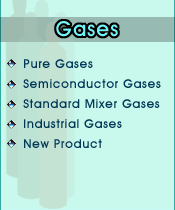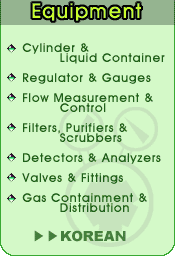|
1. When tightening compression fittings
use two wrenches to prevent putting unnecessary torque on the high
pressure tubing. Do not tighten compression fittings when the lines
are under pressure.
2. When introducing toxic, flammable
or corrosive gases into a system, first test the systems for leaks
using an inert gas such as helium.
3. Never use a flame to check for
leaks.
4. Keep regulators and other equipment
in the same gas service. Do not change service or adapt equipment
without consulting your supplier.
5. Follow these steps when using a
pressure regulator.
1) Make sure the cylinder valve
and connection match.
2) Be sure the regulator construction
materials are compatible with the gas and that the cylinder pressure
gauge will withstand the cylinder pressure.
3) Attach regulator to the cylinder.
4) Turn the pressure control
handle all the way out(counter clockwise).
5) Turn regulator outlet to
off.
6) Do not stand in front of
the gauges. Wear safety glasses.
7) Open the gas cylinder valve
slowly.
8) check for leaks.
9) Adjust the delivery pressure.
10) Open the regulator outlet valve.
6. Acetylene cylinders should be stored
in an upright position. If they have been laying in a flat position
allow to stand in the upright position for one hour prior to using.
7. Safety devices in cylinders and
valves are there for your protection. Do not tamper with them.
8. Use a purge assembly to remove
toxic, corrosive or flammable gases when breaking into a system
for repair and maintenance and when changing cylinders.
9. Do not accept cylinders that are
not properly labeled. Read the labels provided to assure you have
the right gas.
10. Know the gas before you work with
it.
11. Use correct discharge controls.
1) Always
use a secondary control such as a pressure regulator or manual control
valve.
2) Do not
the cylinder valve to dispense the gas.
12. Make sure the materials of construction
of your system are compatible with the gas to be used. Refer to
the Materials Compatibility Guide.
13. Wear protective clothing and goggles
when working with corrosive gases.
14. Have proper safety equipment on
hand. Protective clothing, goggles, air pack, fire extinguisher,
eye bath safety, shower, etc.
15. Always read the labels provided.
Make sure you have received the gas you ordered.
16. Separate empty and full cylinders
in storage. Connecting an empty cylinder to a pressurized system
could cause contamination or a violent reaction within the cylinder.
17. Ground all lines and equipment
used with flammable gases.
18. Always secure cylinders before
removing the cylinder valve protection cap.
19. Use a cylinder hand truck to move
cylinders. Do not drag or roll cylinders. You may injure yourself
or someone nearby.
20. Protect cylinders from temperature
extremes. Never heat cylinders above 50 ¡É.
21. Wear safety glasses when working
with compressed gases.
22. Use a check valve, trap or vacuum
break to prevent suck-back of foreign materials into the cylinder.
If suck-back occurs notify your supplier immediately that foreign
material has entered the cylinder.
23. Leave corrosive gas systems, such
as hydrogen chloride, under inert gas pressure when not in use.
24. Cylinder safety rules
1) Proper lifting techniques
should be used in lifting.
2) Use approved handcart to
move > 2 m.
3) Do not lift using cylinder
cap.
4) Move with cylinder cap and
vaportight cap/plug in place.
5) Cylinders shall not be marked
" Empty" unless they have been purged with inert gas.
6) Do not reduce pressure to
< 5 kg/cm2.
7) Do not fill cylinder with
another gas.
8) Heat cylinders only with
approved devices and never above 50¡É.
9) Do not cool cylinders below
-30¡É.
10) Do not allow cylinders to become
part of an electric circuit.
|








